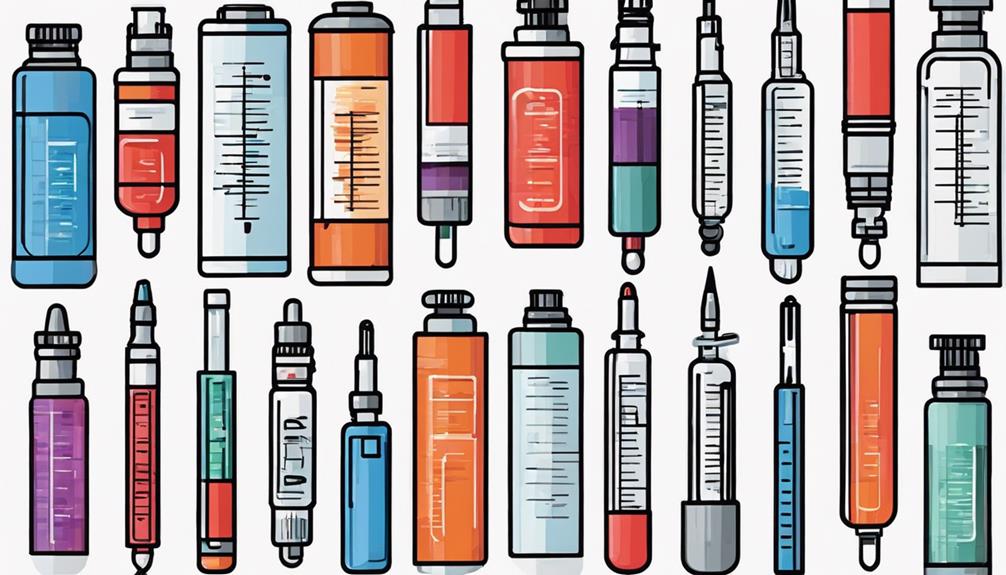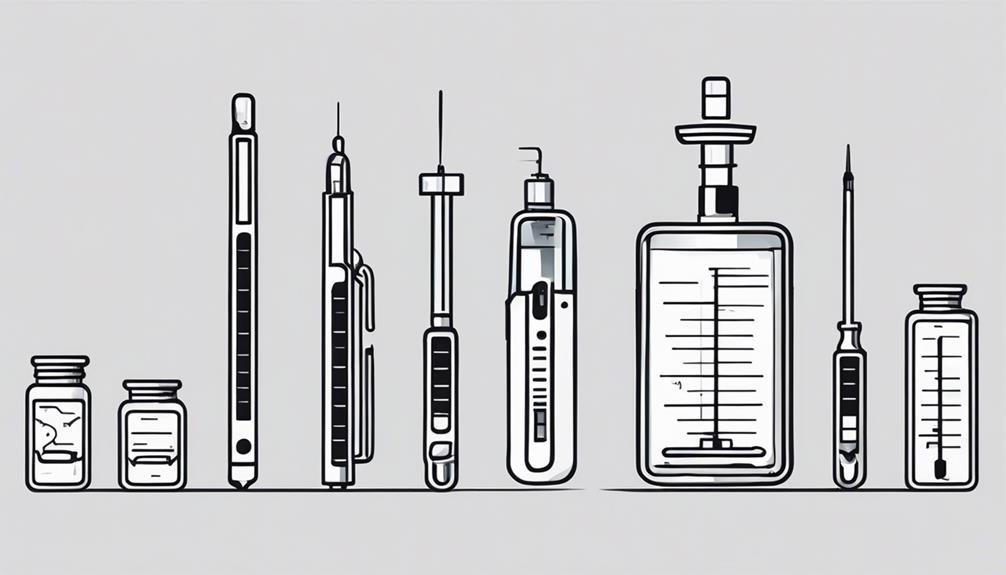Imagine managing your type 2 diabetes is like conducting an orchestra. Just as each instrument plays a crucial role in creating beautiful music, finding the right insulin strategy is key to harmonizing your blood sugar levels.
But with a multitude of insulin options and dosing techniques, where do you start? Let's explore some effective strategies to help you fine-tune your diabetes management and achieve optimal control.
Key Takeaways
- Proper insulin selection and timing are crucial for managing type 2 diabetes effectively.
- Initiate insulin therapy based on evidence-based guidelines and individualized patient needs.
- Monitor blood glucose levels regularly to adjust insulin dosing for optimal outcomes.
- Master insulin injection techniques to ensure safe and effective administration.
Types of Insulin for Type 2 Diabetes

When managing Type 2 diabetes, selecting the appropriate type of insulin is crucial for effective blood sugar control. Understanding insulin delivery methods and timing is essential in managing insulin resistance mechanisms. For individuals with Type 2 diabetes, insulin resistance may occur due to various factors such as obesity, physical inactivity, and genetic predisposition. To manage this resistance effectively, insulin therapy becomes necessary.
Insulin can be administered through various delivery methods, including insulin pens, syringes, and insulin pumps. The choice of delivery method depends on individual preferences, lifestyle, and treatment goals. Timing of insulin administration is also crucial to mimic the body's natural insulin secretion pattern. This helps in optimizing blood sugar levels throughout the day and preventing complications associated with high or low blood sugar.
Consulting with a healthcare provider is essential to determine the most suitable type of insulin, delivery method, and timing for effective management of Type 2 diabetes and insulin resistance.
Insulin Initiation Guidelines
To effectively guide the initiation of insulin therapy in individuals with Type 2 diabetes, adherence to evidence-based insulin initiation guidelines is paramount. When facing insulin initiation challenges, patient education plays a crucial role. Patients must understand the rationale behind starting insulin, potential side effects, and how to self-monitor blood glucose levels. Effective patient education enhances treatment adherence and overall outcomes.
Insulin resistance management is a key consideration in initiating insulin therapy. Lifestyle modifications such as a balanced diet, regular physical activity, and weight management can help improve insulin sensitivity, making insulin therapy more effective. Prioritizing these lifestyle changes alongside insulin initiation can lead to better glycemic control and reduce the amount of insulin needed over time.
Guidelines recommend starting with basal insulin in most cases, titrating the dose based on fasting blood glucose levels. In some instances, initiating premixed insulin or adding rapid-acting insulin before meals may be necessary. It's essential to individualize treatment plans based on patient needs and responses, ensuring optimal outcomes in Type 2 diabetes management.
Insulin Dosing and Titration

Insulin dosing and titration in Type 2 diabetes management require precise adjustments based on individual patient responses and glycemic control goals. Managing insulin resistance effectively involves making dosing adjustments as needed to achieve optimal blood sugar levels. It's crucial for individuals with Type 2 diabetes to understand the importance of adhering to their prescribed insulin regimen. Patient education plays a key role in ensuring they comprehend how insulin works in their bodies and the significance of consistent dosing.
To manage insulin resistance, healthcare providers often need to tailor dosing based on factors such as diet, exercise, stress levels, and other medications the individual may be taking. Regular monitoring of blood glucose levels helps determine the efficacy of the current insulin regimen and guides titration decisions. Additionally, offering support for medication adherence is vital in achieving successful diabetes management outcomes. Patients who feel empowered and well-informed about their treatment plan are more likely to adhere to their insulin dosing schedule, leading to better glycemic control.
Insulin Injection Techniques
For optimal effectiveness in managing Type 2 diabetes, mastering proper insulin injection techniques is essential. When administering insulin, paying attention to details can significantly impact your blood sugar control. Here are three crucial aspects to consider:
- Injection Sites: Rotate your injection sites to prevent lipodystrophy, a condition where fatty tissue under the skin is damaged. Common injection sites include the abdomen, thighs, buttocks, and upper arms. Rotating sites helps ensure consistent insulin absorption and reduces the risk of developing lumps or skin changes at the injection site.
- Needle Disposal: Dispose of needles safely in a puncture-proof container. Sharps containers are designed for safe needle disposal. Never recap needles or leave them in open trash bins, as this poses a risk of accidental needle sticks to yourself or others.
- Proper Injection Technique: Ensure you inject at the correct angle and depth. Pinch the skin if needed, inject at a 90-degree angle for most individuals, and hold the needle in place for a few seconds after injecting to ensure the full dose is delivered.
Mastering these techniques won't only make your insulin administration more effective but also safer for you and those around you.
Monitoring Blood Glucose Levels
Monitoring blood glucose levels accurately is crucial for effectively managing Type 2 diabetes and making informed decisions about your treatment plan. Continuous glucose monitoring (CGM) systems offer real-time data on your glucose levels throughout the day, providing valuable insights into how your body responds to food, exercise, and medication. These devices use a sensor inserted under your skin to measure glucose levels in the interstitial fluid, giving you a more comprehensive view of your blood sugar trends compared to traditional fingerstick testing.
Self-monitoring blood glucose (SMBG) remains an essential tool for diabetes management, allowing you to check your blood sugar levels at home using a glucometer. Regular monitoring helps you track how well your treatment plan is working, identify patterns, and make timely adjustments with the guidance of your healthcare provider. By combining CGM for continuous insights and SMBG for spot-checks and calibration, you can take control of your diabetes management and strive for better overall health.
Frequently Asked Questions
Are There Any Alternative Therapies or Natural Remedies That Can Help Manage Blood Sugar Levels in Type 2 Diabetes?
When managing blood sugar levels in type 2 diabetes, consider alternative therapies like herbal supplements and acupuncture. These may offer additional support alongside conventional treatments. Always consult with your healthcare provider before incorporating new remedies.
How Does Stress or Mental Health Impact Insulin Effectiveness in Type 2 Diabetes Management?
When dealing with type 2 diabetes, your mental health plays a crucial role in how well insulin works. Stressors can affect its effectiveness, but coping mechanisms like mindfulness can help manage these impacts and improve overall outcomes.
Can Certain Foods or Dietary Patterns Affect Insulin Sensitivity in Individuals With Type 2 Diabetes?
When managing Type 2 diabetes, focus on carb timing and glycemic index to improve insulin sensitivity. Opt for whole grains, fruits, and vegetables to help control blood sugar levels. These dietary choices can positively impact your condition.
Are There Any Specific Exercises or Physical Activities That Can Enhance the Effects of Insulin in Type 2 Diabetes Patients?
Engaging in resistance training, high-intensity interval training, yoga, or meditation can amplify insulin effects in type 2 diabetes. These activities promote glucose uptake, improve insulin sensitivity, and enhance overall metabolic health, offering you effective strategies for managing your condition.
How Does Sleep Quality and Duration Influence Insulin Resistance and Blood Sugar Control in Type 2 Diabetes?
When it comes to managing type 2 diabetes, you may wonder how your sleep quality and duration affect blood sugar control. Improving sleep hygiene can enhance metabolism, regulate circadian rhythms, and help reduce insulin resistance, ultimately benefiting your overall health.
Conclusion
So, what're effective insulin strategies for type 2 diabetes?
The types of insulin, initiation guidelines, dosing and titration, injection techniques, and monitoring blood glucose levels are all crucial aspects to consider.
By carefully following these strategies, individuals with type 2 diabetes can effectively manage their condition and improve their overall health.
Stay informed, stay proactive, and work closely with healthcare professionals to find the best insulin regimen for your unique needs.
Stay tuned for more updates on diabetes management.